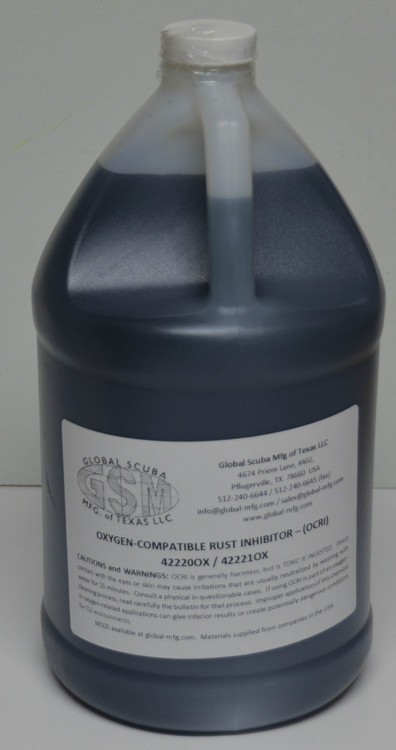- Messages
- 8,584
- Reaction score
- 7,290
- # of dives
- 2500 - 4999
Can you O2 clean steel
Welcome to ScubaBoard, the world's largest scuba diving community. Registration is not required to read the forums, but we encourage you to join. Joining has its benefits and enables you to participate in the discussions.
Benefits of registering include
Because 1) there is nothing organic that can oxidize in phosphoric acid, the steel itself is more likely to combust than phosphoric acid "residue" (hint there isn't any) and 2) if you go re-washing it after your acid wash...
you are that much more likely to just reflash rust the interior which kind of negates the whole point of the acid wash in the first place. So yes, I wash with simple green to remove any oils, swap to phosphoric acid, rinse and dry it. Its perfect that way
Maybe I'm wrong, then. But I can't see that doing an acid wash and then saying "good enough, fill 'er up with oxygen!" would be a good idea. Would you do that?
I’m trying to avoid going the tumbler route at home. I think I'm gonna give this method a try. You just slosh some cleaning solution around in the tank and then do the same with the phosphoric acid solution?
Thinking I would add some compound o rust inhibitor as a third step and leave the tanks inverted to dry.
Would you use the same process for aluminum tanks, minus the rust inhibitor?
compound "o" is an oxygen safe rust inhibitor sold for use in scuba tanks. i've been using it in my tanks that i tumble vip and fill for about 5 years nowOK, you picked a very bad time to write this reply: I’m still in a bad mood after writing the reply above!
First of all, this is for steel tanks only. None of this should be done for aluminum tanks.
Second of all, I wouldn’t characterize any of this as “slosh some cleaning solution around”. There is a lot more involved.
Third of all, the concept of “add some compound o (sic) rust inhibitor” sounds terrible. These are breathing air tanks. The idea of chucking random chemicals in there because of their industrial properties alone does not sound… appealing to me. And that doesn’t even address whether that random chemical is oxygen compatible or not. You didn’t mention oxygen cleanliness, but I’m adding this for completeness.
Fourth, using said random industrial chemicals because it might allow you to “leave the tanks inverted to dry” sounds like choosing a bad idea to allow yourself to be lazy. With my concern already heightened because of my second point above, this point merely reinforces that concern.
My suggestion: don’t even think about doing any of this. Honestly, it’s not that hard of a process to do. But it requires a couple of hours, a small amount of equipment, and most importantly, a desire to do it right. If you don’t have those things, don’t do it. Have it done by someone who will.
I fully admit that this is a reply to a post that has irritated me, after having made a reply to a post that has irritated me. So I acknowledge the harshness. but I’m leaving it.
I also acknowledge the irony that I am upset at someone for taking this too sloppily, after replying to someone who might have considered themselves as taking it more seriously. But in the end, my problem is ignorance: opinions with no basis stated as fact, or randomly changing the process with unknown chemicals out of laziness.
Don’t do that.

compound "o" is an oxygen safe rust inhibitor sold for use in scuba tanks. i've been using it in my tanks that i tumble vip and fill for about 5 years now
would you have been less offended if i said "fill the tanks with a precise amount of solution and then roll them around on the floor with your foot?"
Yeah, sorry. I didn’t mean to come off as flippant. I was just trying to briefly summarize the process in simple terms.Thank you for the clarification. Sidenote: capitalization exists for a reason. At least then I would’ve known to look for a specific chemical instead of suspecting a typo.
Yes. Marginally.
Your entire post screamed vague and lazy corner-cutting to me. Your reply makes it a little less vague, but just swaps it with confirmation bias.
So to answer your original question with your additional detail: the procedure you outline does not match the procedure I have tested. You will have to decide for yourself if your process will work for you. It is not a procedure I personally would be interested in trying.
Yeah, sorry. I didn’t mean to come off as flippant. I was just trying to briefly summarize the process in simple terms.
This might be partly why you need a rust inhibitor in the first place. You want to be rinsing with the tank inverted and with the hottest water you have (120+F/45C) until the tank itself is downright warm and the water is residue free. Then blow dry with compressed gas (scuba air is fine). The warm tank and warm (residual) moisture with very dry air will facilitate evaporation and minimize flash rust.Yeah, sorry. I didn’t mean to come off as flippant. I was just trying to briefly summarize the process in simple terms.
I like the idea of using hot water to rinse the tanks, I’ve just always rinsed with cold water followed by compound “o” before putting the tanks on a dryer.
Because, according to my training in O2-cleaning tanks, the oxygen-cleaning process was supposed to be the very last step.So, with no direct knowledge of what’s going on, you voluntarily make a strong statement saying that “The tank would Definitely Not be oxygen-clean after an acid-wash”? Why would you do *that*?
